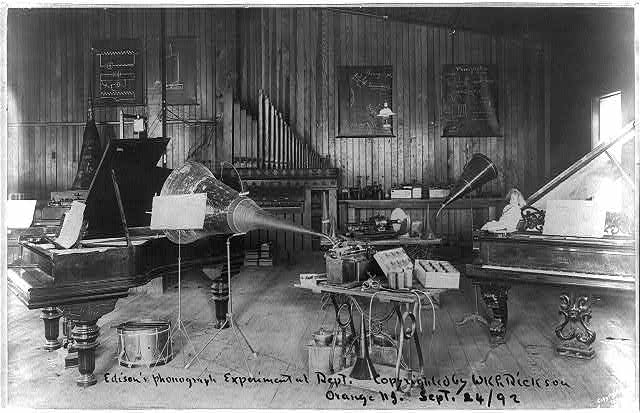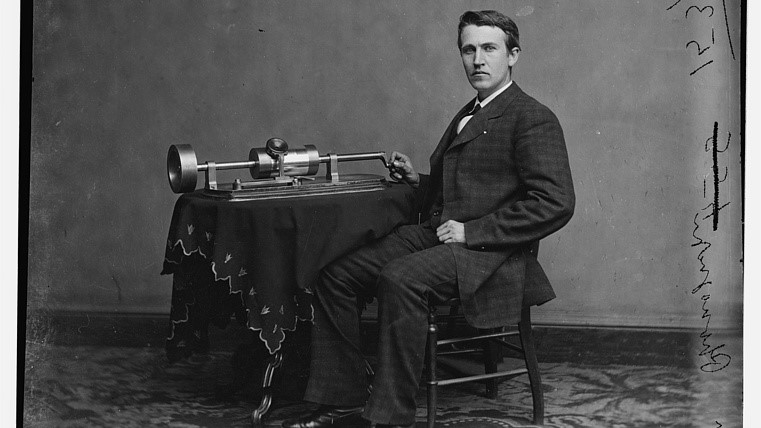On December 24, 1877, inventor Thomas Edison filed for a patent for his “talking machine” or cylinder phonograph. This technology was transformative, successfully reproducing recorded sound and thus setting the stage for our experience of listening to the music we love whenever and wherever we want to!
To celebrate this important date in sound history, it is worth briefly exploring the story of Edison’s early work in recorded sound. Other inventors had already made inroads with different technologies that facilitated communication and transmitted sound – for instance, Samuel Morse with the telegraph in 1844, and Alexander Graham Bell with the telephone in 1876. However, the recording and playback of sound had not been achieved before Edison’s work, the result of several months of diligent labor on the concept of the phonograph. He marked his success with the recording and playback of his own recitation of the nursery rhyme “Mary Had a Little Lamb,” and his remembrance of this occasion can be heard below. Later Edison noted: “I was never so taken aback in my life – I was always afraid of things that worked the first time.”
Two months after filing, the patent for Edison’s phonograph was issued on February 19, 1878. At first, Edison thought that his machine would be primarily useful in the business world as a correspondence and dictation device. Along with that function, however, he envisioned various other uses, including the connection to playing music:
- Phonographic books for blind people
- A device for teaching elocution
- The reproduction of music
- A “family record” machine to record memories, sayings, last words of dying relatives, etc.
- Music boxes and toys
- “Talking” clocks that could keep you on schedule
- To preserve languages and their pronunciation
- An educational resource to preserved teachers’ lessons and explanations for later referral
- To record telephone conversations

The general way these early cylinder phonographs worked was that a person would talk (or sing) into the large end of an acoustic recording horn, which fit into a machine housing a diaphragm and stylus. The sound wave vibrations caused a carriage arm to move across a metal cylinder wrapped in tinfoil (later these became wax cylinders) upon which the stylus inscribed a continuous vertical groove – thus recording the sound being made, which could then later be played back and listened to with delight!
Edison bowed out of the phonograph field for almost 10 years as he concentrated on creating and mass-producing the electric light bulb – creating light out of the darkness in wealthy homes and many cities. But when he returned to the technology of recorded sound, he was continually innovating and producing new models and types of phonographs, and one of his subsidiaries – Columbia Phonograph Company – had also been producing cylinder recordings of popular music of the day. As with most technology, competitors arose and new versions and innovations were developed throughout this time, including the graphophone of Alexander Graham Bell, Chichester Bell, and Charles Sumner Tainter and Emile Berliner’s disc gramophone, and the switch from acoustic horn to electric microphone recording. And with them, and over the following years, came more and more musical recordings by different companies and within a variety of genres – from what is widely considered the first “satisfactory” musical recording (of Italian tenor Enrico Caruso) in 1902 to the later early “hillbilly” tunes of the 1920s that we know and love.

Edison’s phonograph experimental laboratory in Orange, New Jersey, in 1892. Image from the Library of Congress
This blog post shares only one small part of Edison’s story – and an even smaller part of the story of recorded sound. If you want a much fuller history of Edison’s work and impact, there is much to be found on the internet – including a great article from the Library of Congress. Interestingly, research has also uncovered several older instances of recorded sound – that of the French inventor Edouard-Leon Scott, whose invention, the phonautograph or phono-autograph, produced a sound recording almost 20 years before Edison’s phonograph, including a snipped of the song “Claire de Lune.” Check out this NPR transcript of an interview with Patrick Feaster, one of the researchers, as he describes the discovery, noting: “It’s the earliest recognizable recording of the human voice, the earliest recording of a vocal musical performance, the oldest recognizable snippet of sound in any recognizable language. So, it’s a lot of firsts.”


